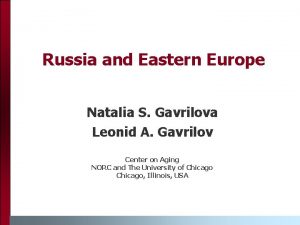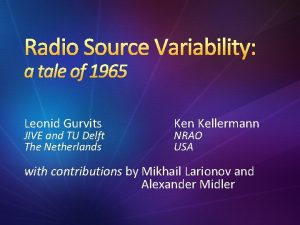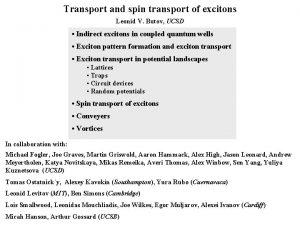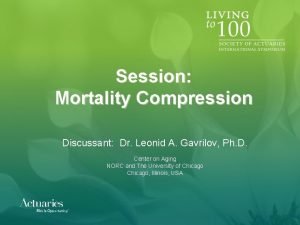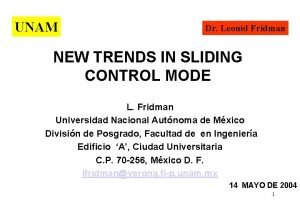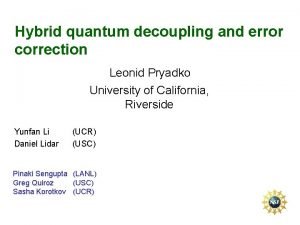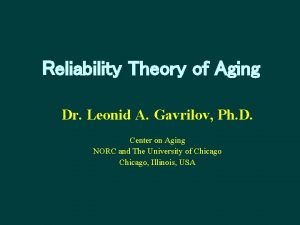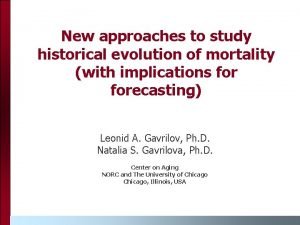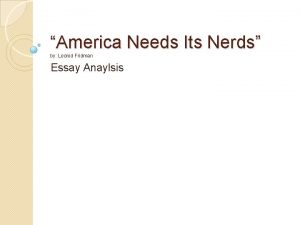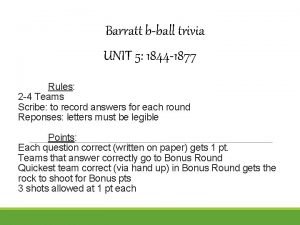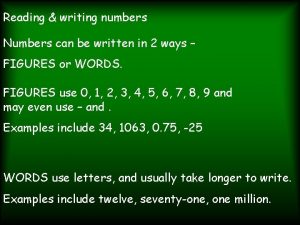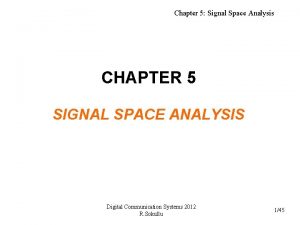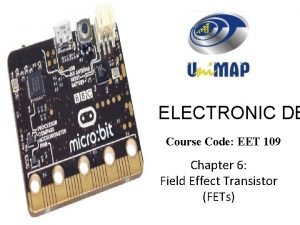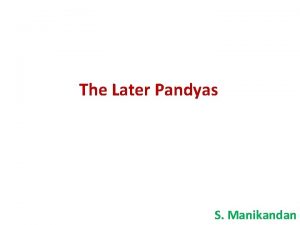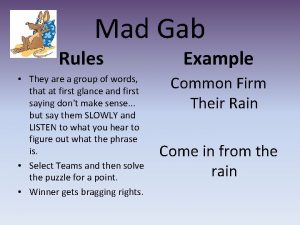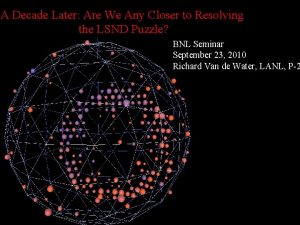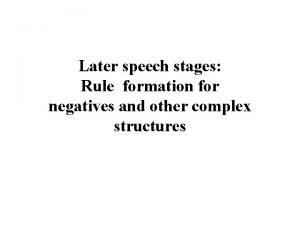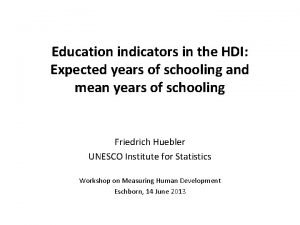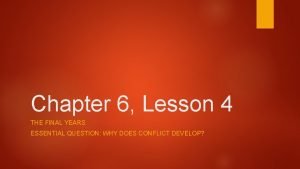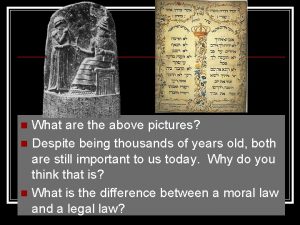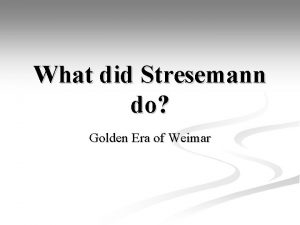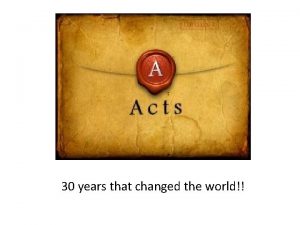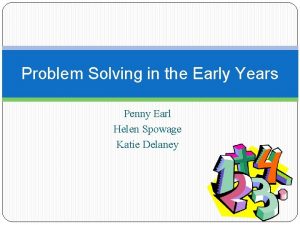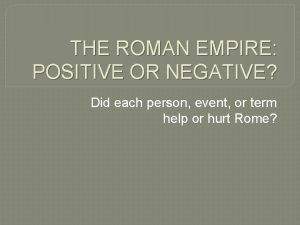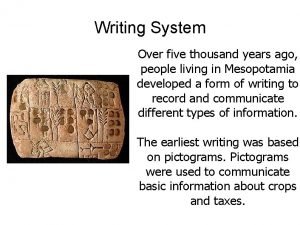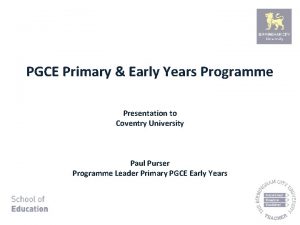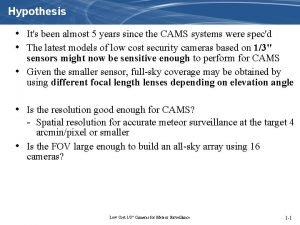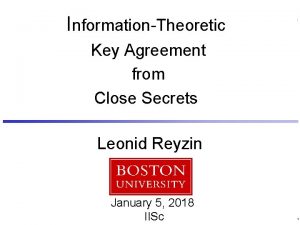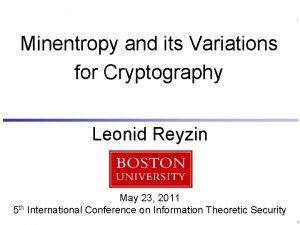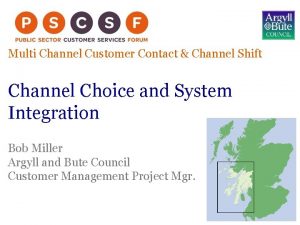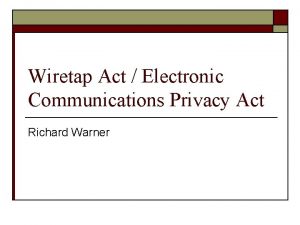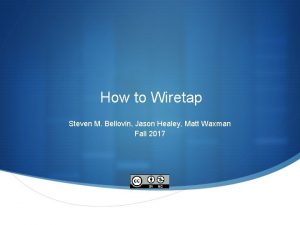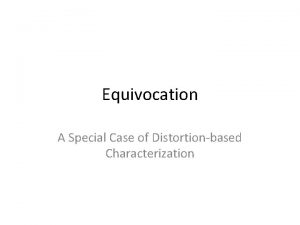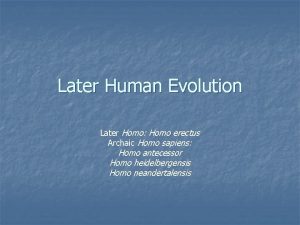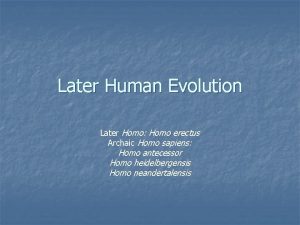Wyners WireTap Channel Forty Years Later Leonid Reyzin















![Note the two views of extractors [Santha-Vazirani]: poor quality randomness Ext indistinguishable from uniform Note the two views of extractors [Santha-Vazirani]: poor quality randomness Ext indistinguishable from uniform](https://slidetodoc.com/presentation_image_h2/d77ef434288738c26802a84f2b2daf81/image-16.jpg)










![Privacy Amplification = Strong Extractor Bob w Alice w e leakag Eve In [Wyner], Privacy Amplification = Strong Extractor Bob w Alice w e leakag Eve In [Wyner],](https://slidetodoc.com/presentation_image_h2/d77ef434288738c26802a84f2b2daf81/image-27.jpg)


![New Model: no authentic channels (besides w) • • [Maurer, Maurer-Wolf 1997, 2003] unauthenticated New Model: no authentic channels (besides w) • • [Maurer, Maurer-Wolf 1997, 2003] unauthenticated](https://slidetodoc.com/presentation_image_h2/d77ef434288738c26802a84f2b2daf81/image-30.jpg)




![Many Kinds of Extractors [robust/n-m] [local] [source-private] [fuzzy] [reusable] Most combinations are interesting and Many Kinds of Extractors [robust/n-m] [local] [source-private] [fuzzy] [reusable] Most combinations are interesting and](https://slidetodoc.com/presentation_image_h2/d77ef434288738c26802a84f2b2daf81/image-35.jpg)
![Many Kinds of Extractors [robust/n-m] [local] [source-private] [fuzzy] [reusable] Interaction: Deterministic / Single-Message / Many Kinds of Extractors [robust/n-m] [local] [source-private] [fuzzy] [reusable] Interaction: Deterministic / Single-Message /](https://slidetodoc.com/presentation_image_h2/d77ef434288738c26802a84f2b2daf81/image-36.jpg)
![Information-Theoretic Protocols Beyond Key Agreement • [Crépeau, Kilian 1988] [Benett, Brassard, Crépeau, Skubiszweska 1991] Information-Theoretic Protocols Beyond Key Agreement • [Crépeau, Kilian 1988] [Benett, Brassard, Crépeau, Skubiszweska 1991]](https://slidetodoc.com/presentation_image_h2/d77ef434288738c26802a84f2b2daf81/image-37.jpg)


















































![When are fuzzy extractors possible? Define min-entropy: H (W) = min −log Pr[w] Necessary: When are fuzzy extractors possible? Define min-entropy: H (W) = min −log Pr[w] Necessary:](https://slidetodoc.com/presentation_image_h2/d77ef434288738c26802a84f2b2daf81/image-88.jpg)






























- Slides: 118

Wyner’s Wire-Tap Channel, Forty Years Later Leonid Reyzin These slides are a superset of the talks given at: - Theory of Cryptography Conference on March 24, 2015 (parts I and II) - École Normale Supérieure Crypto Seminar on March 26, 2015 (parts I and II) - Charles River Crypto Day on April 17, 2015 (parts I and most of III)

Part I History and Context

Two Events in October 1975 Enabled This Talk 1. I was born 2. Aaron D. Wyner published “The Wire-Tap Channel” Aaron Wyner c. 1975 (courtesy of Adi Wyner)

Premise of “The Wire-Tap Channel” Alice noisy channel Bob l a n o i addit ise no Eve (wire-tapper) Goal: transfer information from Alice to Bob reliably while hiding it from Eve Results: Upper/lower bounds on information rate (“secrecy capacity”) Constructive for a special case (in a few slides)

Context: mid-1970 s surge of interest in crypto Alice noisy channel Bob l a n o i addit ise no Eve (wire-tapper) Q: Where Does Secrecy Come From? 1. Public Keys [Diffie-Hellman 1976, Merkle 1978] 2. Secret Keys [Shannon 1949] … [Hellman 1974 -77] 3. Nature [Wyner 1975] Only 5 references: 3 for basic info-theory background +

Simple Special Case Alice noisy channel Bob l a n o i addit ise no Eve (wire-tapper)

Simple Special Case Alice no noise Bob l a n o i addit ise no Eve (wire-tapper)

Simple Special Case Alice no noise Bob h t i w d e ility p p i l f s bit ll probab sma Eve (wire-tapper)

Simple Special Case Alice Securely conveys b = pi no noise p 1 p 2 p 3… Bob h t i w … d eq 3 ility p q p i l 2 f q s bit ll 1 probab sma Eve (wire-tapper) Wyner: XOR amplifies information-theoretic uncertainty • Alice sends a string p = p 1 p 2 p 3… • Eve will see qi =pi noise; most, but not all, qi =pi • Given enough bits, parity of p looks uniform

Yao 1982: “Theory and Applications of Trapdoor Functions” PK Alice Securely conveys b = P(xi) f (x 1), f (x 2), … Bob SK , ) x ( i f f o ) e g x ( d i P e l f w o o e n g k d t e c l Perfe isy” know o n “ t u b Eve (noiseless but bounded wire-tapper) Yao: XOR amplifies computational uncertainty Setup: Weak TDP f (x) with somewhat hardcore predicate P(x) Alice has PK and Bob has SK

Yao 1982: “Theory and Applications of Trapdoor Functions” PK Alice f (x 1), f (x 2), … Bob SK , ) x ( i f f o ) e g x ( d i P e l f Securely w o o e n g k d t e c l Perfe isy” know conveys o n “ t u b b = P(xi) Eve (noiseless but bounded wire-tapper) “this situation has an exact analogue in the classical information theory, known as the Wyner wiretap channel [25]. Wyner showed that even when the noise in [Eve’s] channel is small, [Alice] can magnify the noise by properly encoding [her] messages. ”

Levin 1985, 87 “One-Way Functions and Pseudorandom Generators” (proof of Yao’s XOR Lemma) “One of the important ideas of [Yao 82] is that the methods of [Wyner 75] can be applied for computational as well as for purely probabilistic unpredictability. ”

Back to Wyner Alice Conveys b = pi p = p 1 p 2…, no noise Bob h t i w d e ility p p i l f s bit ll probab sma Eve (wire-tapper) Consider the conditional distribution p | Eve’s knowledge (= U | U binary symmetric noise) Wyner’s observation (reformulated): parity is a deterministic extractor from this distribution Q: Can we do better? (i. e. , extract more bits = increase rate) A [Wyner]: Yes!

Back to Wyner Alice p = p 1 p 2…, no noise Conveys s = Hp (H = parity-check matrix for a linear error-correcting code) Bob h t i w d e ility p p i l f s bit ll probab sma Eve (wire-tapper) Consider the conditional distribution p | Eve’s knowledge (= U | U binary symmetric noise) Wyner’s observation (reformulated): parity is a deterministic extractor from this distribution Q: Can we do better? (i. e. , extract more bits = increase rate) A [Wyner]: Yes! “the coding scheme [above] is based on an idea of Mr. [Colin] Mallows”

Santha-Vazirani 1986 “Generating quasi-random sequences from semi-random sources” “Wyner shows how to achieve optimal rate of communication, using parity-check codes. We show to use the same method to extract quasi-random sequences at a higher rate. ” Thm: Hp is an extractor from any distribution where each bit has pre-selected bounded bias (under stronger demands on quality of output than Wyner)
![Note the two views of extractors SanthaVazirani poor quality randomness Ext indistinguishable from uniform Note the two views of extractors [Santha-Vazirani]: poor quality randomness Ext indistinguishable from uniform](https://slidetodoc.com/presentation_image_h2/d77ef434288738c26802a84f2b2daf81/image-16.jpg)
Note the two views of extractors [Santha-Vazirani]: poor quality randomness Ext indistinguishable from uniform given leakage [Wyner]: randomness (maybe uniform) e leakag Eve

Summary of Wyner’s paper Alice noisy channel Bob al n o i t i add ise no Eve (wire-tapper) Goal: transfer information from Alice to Bob reliably while hiding it from Eve Results: - Derive best achievable “secrecy capacity” - Achieve it constructively for the case above (assuming good linear codes) - Achieve it nonconstructively in all other cases Drawback: Weak notion of security (“low rate of leakage”)

Lessons Alice noisy channel Bob al n o i t i add ise no Eve (wire-tapper) • There is interesting work to do in provable information-theoretic security • Noise can be your friend • Secrets can come from nature

Early Generalization Alice noisy channel Bob al n o i t i add ise no Eve (wire-tapper) [Csiszár-Körner 1978]:

Early Generalization Alice noisy channel r e i s i o n nel chan Eve (wire-tapper) [Csiszár-Körner 1978]: no reason Eve’s channel should be a degraded version of Bob’s: it just needs to be worse Bob

A Different Model for Eve’s Knowledge Alice noisy channel sen o h c a fewositions bit p Eve (wire-tapper) wire-tapper gets to choose [Ozarow-Wyner 1985]: specific symbols to see Result: Hp is still a good deterministic extractor Bob

Adding a Feedback Channel Alice authentic public channel noisy channel ly b i s s o p y s i o n less nnel cha Bob Eve (wire-tapper) [Leung-Yan-Cheong 1976] (Ph. D. Thesis under Hellman), [Maurer 1993], [Ahlswede-Csiszár 1993]: Eve’s channel need not be noisier if Bob has a feedback channel

Generalizing Alice authentic public channel noisy channel ly b i s s o p y s i o n less nnel cha Bob Eve (wire-tapper) • [Bennett, Brassard, Robert 1985, 88] (motivated by quantum): - errors can be adversarial - leakage can be arbitrary

Generalizing Alice authentic public channel arbitrary bounded tampering y l b possi oisy less nnnel cha Bob Eve (wire-tapper) • [Bennett, Brassard, Robert 1985, 88] (motivated by quantum): - errors can be adversarial - leakage can be arbitrary

Generalizing Alice authentic public channel arbitrary bounded tampering y r arbitnrdaed bou age leak Bob Eve (wire-tapper) • [Bennett, Brassard, Robert 1985, 88] (motivated by quantum): - errors can be adversarial information reconciliation - leakage can be arbitrary privacy amplification • Better security notion • Generalized further, better notions of entropy in [Bennett, Brassard, Crépeau, Maurer 1995]

Privacy Amplification Alice authentic public channel no tampering (for now) y r a r t i arb nded bou age leak Bob Eve (wire-tapper) • Bennett-Brassard-Robert: no fixed function will work (as opposed to Wyner’s specific kind of leakage) • But: a random universal hash function is an extractor (“leftover hash lemma”) • Just send the choice of the function (“extractor seed”) over the public channel
![Privacy Amplification Strong Extractor Bob w Alice w e leakag Eve In Wyner Privacy Amplification = Strong Extractor Bob w Alice w e leakag Eve In [Wyner],](https://slidetodoc.com/presentation_image_h2/d77ef434288738c26802a84f2b2daf81/image-27.jpg)
Privacy Amplification = Strong Extractor Bob w Alice w e leakag Eve In [Wyner], these are outcomes of his channel. But can be obtained in other ways. We will speak of w instead of a channel from now on

Privacy Amplification = Strong Extractor seed over authentic public channel Alice w Bob w e leakag Eve seed w Ext r uniform given • Note the power of the public channel: leakage+ seed fewer assumptions on adversarial knowledge • Modified goal: derive a good key (can use public channel once the key is derived)

Privacy Amplification and Extractors Hardness Håstad-Impagliazzo-Levin-Luby 1989, 99 (OWF PRG) another version of the same result: universal hash function is an extractor (thus, three chain from Wyner to extractors: Wyner 75 Yao 82 Levin 87 HILL Wyner 75 Santha-Vazirani Wyner 75 Bennett-Brassard-Robert)
![New Model no authentic channels besides w Maurer MaurerWolf 1997 2003 unauthenticated New Model: no authentic channels (besides w) • • [Maurer, Maurer-Wolf 1997, 2003] unauthenticated](https://slidetodoc.com/presentation_image_h2/d77ef434288738c26802a84f2b2daf81/image-30.jpg)
New Model: no authentic channels (besides w) • • [Maurer, Maurer-Wolf 1997, 2003] unauthenticated public channel Bob Alice w Bob’s last protocol message w last protocol message, r m Eve r Can no longer simply send the extractor seed: adversary may tamper Single-message protocols still possible: “robust” extractors [Maurer-Wolf 97, Boyen-Dodis-Katz-Ostrovsky-Smith 05] but they exist only if w at least ½-entropic [Dodis-Wichs 09] Lots of work on multi-message protocols [RW 03, KR 09, DW 09, CKOR 10, DLWZ 11, CRS 12, Li 15…]; important tool: “non-malleable” extractors [Dodis-Wichs 09] Two kinds of robustness: tampering before/after r is used (pre/post- application) [Dodis-Kanukurthi-Katz-Reyzin-Smith]

New Requirement: Source Privacy • • • unauthenticated public channel Bob Alice w w Risk: tampering Eve may learn something about w by observing how the parties behave after she tampers Standalone security guarantees it won’t be enough to cause problems But what about sequential security? Imagine w is obtained using a secret process; the next one uses the same process Need: “source private” extractors [Bouman, Fehr 2011] (Def’n: an active attack won’t tell Eve anything about w) Relevant in, e. g. , bounded storage model [Maurer 1990] and quantum key distribution

W Alice k • • Bounded Storage Model k Bob w w [Maurer 1990, 92]: W is a HUGE (perhaps streaming) string no one can store Alice and Bob have a short shared secret k for probing W to get w Eve stores arbitrary information about W Need “locally computable” extractors [Lu 2002, 04] – Also used in “bounded retrieval model” [Dziembowski 06] [Di Crescenzo, Lipton, Walfish 06] • k is the secret used to obtain w and needs to be reusable: hence need source privacy

Dealing With Errors Alice w 0 information reconciliation Bob w 1 Eve • Recall that Wyner’s original paper had noise on the main channel, but no constructions for this case • Common approach: reduce to the no-tampering case by performing information reconciliation over public channel • Add whatever leaks during that process to Eve’s knowledge • Solve the no-tampering case using appropriate extractors • Information reconciliation + extractors = “fuzzy extractors” [Dodis-Ostrovsky-Reyzin-Smith 2004, 08]

Applying to Biometrics Alice w 0 information reconciliation Bob w 1 Eve • Most of us have 10 fingers and 2 eyes • Variants of w 0 derived from same iris scan may be used in different systems without coordination • A single-protocol security guarantee doesn’t extend: information reconciliation leakage may be additive • Can we prevent multiple protocols from revealing w 0? • Need: “reusable” extractors [Boyen 2004]
![Many Kinds of Extractors robustnm local sourceprivate fuzzy reusable Most combinations are interesting and Many Kinds of Extractors [robust/n-m] [local] [source-private] [fuzzy] [reusable] Most combinations are interesting and](https://slidetodoc.com/presentation_image_h2/d77ef434288738c26802a84f2b2daf81/image-35.jpg)
Many Kinds of Extractors [robust/n-m] [local] [source-private] [fuzzy] [reusable] Most combinations are interesting and valid as models
![Many Kinds of Extractors robustnm local sourceprivate fuzzy reusable Interaction Deterministic SingleMessage Many Kinds of Extractors [robust/n-m] [local] [source-private] [fuzzy] [reusable] Interaction: Deterministic / Single-Message /](https://slidetodoc.com/presentation_image_h2/d77ef434288738c26802a84f2b2daf81/image-36.jpg)
Many Kinds of Extractors [robust/n-m] [local] [source-private] [fuzzy] [reusable] Interaction: Deterministic / Single-Message / Interactive Input constraints: what’s minimum required entropy Protocol quality: entropy loss, number of rounds if interactive • Ex 1: active adversary, need to handle errors: robust + fuzzy [RW 04, BDKOS 05, DKKRS 06, KR 09, DW 09, CKOR 10, …] • Ex 2: bounded storage model with errors local + fuzzy + source-private [Dodis-Smith 2005] • Ex 3: active adversary, large secret, need to protect source post-app robust + source-private + local [Aggarwal-Dodis-Jafargholi-Miles-Reyzin 2014]
![InformationTheoretic Protocols Beyond Key Agreement Crépeau Kilian 1988 Benett Brassard Crépeau Skubiszweska 1991 Information-Theoretic Protocols Beyond Key Agreement • [Crépeau, Kilian 1988] [Benett, Brassard, Crépeau, Skubiszweska 1991]](https://slidetodoc.com/presentation_image_h2/d77ef434288738c26802a84f2b2daf81/image-37.jpg)
Information-Theoretic Protocols Beyond Key Agreement • [Crépeau, Kilian 1988] [Benett, Brassard, Crépeau, Skubiszweska 1991] [Damgard, Kilian, Salvail 1999] oblivious transfer and variations using noise/quantum • [Crépeau 1997] bit commitment using noise • Other works I probably don’t know about, including many in quantum cryptography

Given all this follow-up, what about Wyner’s paper? 22 1975 36 1985 128 2440 1995 2005 2015 Google Scholar Citation Counts by Decade • Half the total citations are from the 2012 -2015 • Most (? ) are in the info-theory community, nonconstructive, with security definitions that won’t make us happy • Many are due to recent interest in physical-layer security

Given all this follow-up, what about Wyner’s paper? Alice noisy channel r e i s i o n nel chan Bob Eve • Wyner’s model is artificial for crypto community: we assume a free public channel and thus focus on key derivation • Question: what can you do without a free channel (every bit counts – so “derive key + encrypt” loses half the rate) • [Bellare Tessaro Vardy 2012]: first cryptographic treatment (“semantic security”) and first optimal construction

Lessons Alice noisy channel r e i s i o n nel chan Eve Bob

Lessons Alice w 0 public channel Eve (passive or active) Bob w 1 Secrets can come from nature, but we need to tame them Research Directions: • Finding the right notion of security • Minimizing assumptions about adversarial knowledge • Broadening sources of secrets • Understanding fundamental bounds on what’s feasible – Finding the right notion of input entropy • Making it all efficient

Lessons Alice w 0 public channel Eve (passive or active) Bob w 1 Secrets can come from nature, but we need to tame them Research Directions: • Finding the right notion of security • Minimizing assumptions about adversarial knowledge • Broadening sources of secrets • Understanding fundamental bounds on what’s feasible – Finding the right notion of input entropy • Making it all efficient

Part II Fuzzy Extractors for Noisy Sources with More Errors than Entropy Ran Canetti, Benjamin Fuller, Omer Paneth, Leonid Reyzin, and Adam Smith http: //eprint. iacr. org/2014/243

Our Setting Alice w 0 information reconciliation + privacy amplification Bob w 1 Non-Tampering Eve • Single message: Alice and Bob can be the same person at different times • Target application: key extraction from unique physical features Physically Unclonable Functions (PUFs) Biometrics

Notation • Enrollment algorithm Gen (Alice): Take a measurement w 0 from the source. Use it to “lock up” a random output in a nonsecret value p. • Subsequent algorithm Rep (Bob): give same output if d(w 0, w 1) < t • Security: r looks uniform even given p, whenever the source is good enough Gen w 0 <t w 1 r p Rep r

Fuzzy Extractors: Goals • Goal 1: handle as many sources as possible (typically, any source in which w 0 is 2 k hard to guess) • Goal 2: handle as much error as possible (typically, any w 1 within distance t) • Most previous approaches are analyzed in terms of t and k This work: handle t > k entropy k w 0 <t w 1 Gen r p Rep r

Fuzzy Extractors: Typical Construction - derive r using a randomness extractor (converts high-entropy sources to uniform, e. g. , via universal hashing) - correct errors using a secure sketch (gives recovery of the original from a noisy signal e. g. , via the “checksum” bits of an error-correcting code) entropy k w 0 <t w 1 Gen r Ext p Rep r Ext

Fuzzy Extractors: Typical Construction - derive r using a randomness extractor (converts high-entropy sources to uniform, e. g. , via universal hashing) - correct errors using a secure sketch (gives recovery of the original from a noisy signal e. g. , via the “checksum” bits of an error-correcting code) entropy k w 0 <t w 1 Gen r Ext p Sketch Rep Rec r w 0 Ext

Problem with Secure Sketches • p must store enough information to let you recover w 0 • How much information is that? entropy k w 0 <t w 1 Gen r Ext p Sketch Rep Rec r w 0 Ext

Problem with Secure Sketches p must store enough information to let you recover w 0 How much information is that? w 0 could be anywhere within distance t, so log|Bt | > t bits No security left if t > k (can be made rigorous for large classes of sources) • Observation: not necessary to recover w 0 • • stores t bits about w 0 <t w 1 Bt p has k < t bits of entropy Rep Rec r w 0 Ext

Is it possible to handle “more errors than entropy” (t > k)? t • Consider some distribution for w 0 with entropy k • Suppose t > k • Then Bt > 2 k • Possibly |Bt| > # of possibilities for w 0 • Possibly all w 0 lie in a single ball • No matter what we do, adversary can get the output by running Rep on w 1 = center of that ball w 1 Rep r

Is it possible to handle “more errors than entropy” (t > k)? t w 1 Rep w 1 But if all the points are far apart, the problem is trivial! (at least information-theoretically) r

Is it possible to handle “more errors than entropy” (t > k)? t w 1 Rep w 1 No construction that is analyzed only in terms of t and k can distinguish the two cases r

Is it possible to handle “more errors than entropy” (t > k)? t w 1 Rep w 1 Moral: our constructions will exploit structure in the source (not “any source of a given k” like prior work) r

What Sources Can We Handle? 1. Sources with high-entropy samples w 0 = a 1 a 2 a 3 a 4 a 5 a 6 a 7 a 8 a 9 sample: a 2 a 5 a 7 We need: for some superlog sample size you are guaranteed to get superlog entropy Sufficient assumption: somewhat q-wise independence for superlogarithmic q E. g. , Iris. Code [Daugman] is redundant and noisy (t>>k): log |Bt| ≈ 900 but k ≈ 250 Yet this assumption is plausible

Idea: “encrypt” r using parts of w 0 Source: a string of symbols, arbitrary alphabet Errors: Hamming Gen: - get random combinations of symbols in w 0 - “lock” rr using these combinations w 0 = a 1 a 2 a 3 a 4 a 5 a 6 a 7 a 8 a 9 r a 1 a 9 a 2 r a 3 a 9 a 5 r a 3 a 4 a 5 r a 7 a 5 a 6 r Gen r a 2 a 8 a 7 p r a 3 a 5 a 2

Idea: “encrypt” r using parts of w 0 Source: a string of symbols, arbitrary alphabet Errors: Hamming Gen: - get random combinations of symbols in w 0 - “lock” rr using these combinations w 0 = a 1 a 2 a 3 a 4 a 5 a 6 a 7 a 8 a 9 r a 1 a 9 a 2 r a 3 a 9 a 5 r a 3 a 4 a 5 r a 7 a 5 a 6 r Gen r a 2 a 8 a 7 p r a 3 a 5 a 2

Idea: “encrypt” r using parts of w 0 Source: a string of symbols, arbitrary alphabet Errors: Hamming Gen: - get random combinations of symbols in w 0 - “lock” rr using these combinations w 0 = a 1 a 2 a 3 a 4 a 5 a 6 a 7 a 8 a 9 r a 1 a 9 a 2 r a 3 a 9 a 5 r a 3 a 4 a 5 r a 7 a 5 a 6 r Gen r a 2 a 8 a 7 p r a 3 a 5 a 2

Idea: “encrypt” r using parts of w 0 Source: a string of symbols, arbitrary alphabet Errors: Hamming Gen: - get random combinations of symbols in w 0 - “lock” rr using these combinations - p = locks + positions of symbols needed to unlock w 0 = a 1 a 2 a 3 a 4 a 5 a 6 a 7 a 8 a 9 r a 1 a 9 a 2 r a 3 a 9 a 5 r a 3 a 4 a 5 r a 7 a 5 a 6 r Gen r a 2 a 8 a 7 p r a 3 a 5 a 2

Idea: “encrypt” r using parts of w 0 Source: a string of symbols, arbitrary alphabet Errors: Hamming Gen: - get random combinations of symbols in w 0 - “lock” rr using these combinations - p = locks + positions of symbols needed to unlock w 0 = a 1 a 2 a 3 a 4 a 5 a 6 a 7 a 8 a 9 r a 1 a 9 a 2 r a 3 a 9 a 5 r a 3 a 4 a 5 r a 7 a 5 a 6 r Gen r a 2 a 8 a 7 p r a 3 a 5 a 2

Idea: “encrypt” r using parts of w 0 Source: a string of symbols, arbitrary alphabet Errors: Hamming Gen: - get random combinations of symbols in w 0 - “lock” rr using these combinations - p = locks + positions of symbols needed to unlock p r a 1 a 9 a 2 r a 3 a 9 a 5 r a 3 a 4 a 5 r a 7 a 5 a 6 r a 2 a 8 a 7 r a 3 a 5 a 2

Idea: “encrypt” r using parts of w 0 Source: a string of symbols, arbitrary alphabet Errors: Hamming Gen: - get random combinations of symbols in w 0 - “lock” rr using these combinations - p = locks + positions of symbols needed to unlock Rep: w 1 = a 1 a 2 a 3 a 4 a 5 a 6 a 7 a 8 a 9 Rep p r a 1 a 9 a 2 r a 3 a 9 a 5 r a 3 a 4 a 5 r a 7 a 5 a 6 r a 2 a 8 a 7 r r a 3 a 5 a 2

Idea: “encrypt” r using parts of w 0 Source: a string of symbols, arbitrary alphabet Errors: Hamming Gen: - get random combinations of symbols in w 0 - “lock” rr using these combinations - p = locks + positions of symbols needed to unlock Rep: w 1 = a 1 a 2 a 3 a 4 a 5 a 6 a 7 a 8 a 9 Rep p r a 1 a 9 a 2 r a 3 a 9 a 5 r a 3 a 4 a 5 r a 7 a 5 a 6 r a 2 a 8 a 7 r r a 3 a 5 a 2

Idea: “encrypt” r using parts of w 0 Source: a string of symbols, arbitrary alphabet Errors: Hamming Gen: - get random combinations of symbols in w 0 - “lock” rr using these combinations - p = locks + positions of symbols needed to unlock Rep: Use the symbols of w 1 to open at least one lock w 1 = a 1 a 2 a 3 a 4 a 5 a 6 a 7 a 8 a 9 Rep p r a 1 a 9 a 2 r a 3 a 9 a 5 r a 3 a 4 a 5 r a 7 a 5 a 6 r a 2 a 8 a 7 r r a 3 a 5 a 2

Idea: “encrypt” r using parts of w 0 Source: a string of symbols, arbitrary alphabet Errors: Hamming Gen: - get random combinations of symbols in w 0 - “lock” rr using these combinations - p = locks + positions of symbols needed to unlock Rep: Use the symbols of w 1 to open at least one lock w 1 = a 1 a 2 a 3 a 4 a 5 a 6 a 7 a 8 a 9 Rep p r a 1 a 9 a 2 r a 3 a 9 a 5 r a 3 a 4 a 5 r a 7 a 5 a 6 r a 2 a 8 a 7 r r a 3 a 5 a 2

Idea: “encrypt” r using parts of w 0 Source: a string of symbols, arbitrary alphabet Errors: Hamming Gen: - get random combinations of symbols in w 0 - “lock” rr using these combinations - p = locks + positions of symbols needed to unlock Rep: Use the symbols of w 1 to open at least one lock Error-tolerance: as long as at least one combination is ok Security: each combination must have enough entropy r a 1 a 9 a 2 r a 3 a 9 a 5 r a 3 a 4 a 5 r a 7 a 5 a 6 r a 2 a 8 a 7 r a 3 a 5 a 2

How to implement locks? r a 1 a 9 a 2 R. O. model [Lynn Prabhakaran Sahai 04]: lock = nonce, Hash(nonce, a 1 a 9 a 2) (r||00… 0)

How to implement locks? • A lock is the following program: – If input = a 1 a 9 a 2, output r – Else output • Obfuscate this program! r a 1 a 9 a 2 – Obfuscation: preserve functionality, hide the program – Obfuscating this specific program gives a “digital locker”: encryption of r that is secure even multiple times with correlated and weak keys [Canetti Kalai Varia Wichs 10] – For this specific program: obfuscation is practical (R. O. or DL-based) [Canetti Dakdouk 08], [Bitansky Canetti 10] – Hiding r as long as the input can’t be exhaustively searched (superlogarithmic entropy)

How to implement locks? • A lock is the following program: – If input = a 1 a 9 a 2, output r – Else output r a 1 a 9 a 2 • Q: if you are going to use obfuscation, why not this: w 0 Gen Pick random r p = obfuscate{ if dis(w 0, ) t r else } r p Rep Send input to the obfuscated program p r w 1 • A: you can do that [Bitansky Canetti Kalai Paneth 14], except it’s very impractical + has a very strong assumption

How good is this construction? • We can correct more errors than entropy! • For correctness: need sublinear error • Note: computational, not information-theoretic, security r a 1 a 9 a 2 r a 3 a 9 a 5 r a 3 a 4 a 5 r a 7 a 5 a 6 r a 2 a 8 a 7 r a 3 a 5 a 2

How good is this construction? • It is reusable! – Same source can be enrolled multiple times with multiple independent services w 0'' r Gen p r' Gen p' r'' Gen p'' Secret even given p, p’’, r, r’'

How good is this construction? • It is reusable! – Same source can be enrolled multiple times with multiple independent services – Follows from composability of obfuscation – In the past: difficult to achieve, because typically new enrollments leak fresh information – Previous constructions: non-fuzzy [Dodis Kalai Lovett 09] or all readings must differ by fixed constants [Boyen 2004] – Our construction: each reading individually must satisfy our conditions

What Sources Can We Handle? 1. Sources with high-entropy samples (with reusability)! 2. Sources with sparse high-entropy marginals (requires large alphabets) Constraint: individual symbols have high entropy (but no independence assumed) w 0 = a 1 a 2 a. OR 3 a 4 a 5 a 6 r r a 1 r a 2 r a 3 a 4 r a 5 r a 6

Construction for Sparse High-Entropy Marginals Problem: each low-entropy symbol reveals one bit of r w 0 = a 1 a 2 a 3 a 4 a 5 a 6 r r a 1 r a 2 r a 3 a 4 r a 5 r a 6

Construction for Sparse High-Entropy Marginals Problem: each low-entropy symbol reveals one bit of r Solution: use a randomness extractor at the end w 0 = a 1 a 2 a 3 a 4 a 5 a 6 r r a 1 r a 2 r a 3 a 4 r a 5 r a 6

Construction for Sparse High-Entropy Marginals w 0 = a 1 a 2 a 3 a 4 a 5 a 6 r r a 1 r a 2 r a 3 a 4 r a 5 r a 6

Construction for Sparse High-Entropy Marginals Problem: differences in w 1 will make us miss some bits Solution: use an error-correcting code w 1 = a 1 a 2 a 3 a 4 a 5 a 6 r r a 1 r a 2 r a 3 a 4 r a 5 r a 6

What Sources Can We Handle? 1. Sources with high-entropy samples: with reusability! (subconstant error rate) 2. Sources with sparse high-entropy marginals: with constant error rate! (requires large alphabets) 3. Sparse block sources information theoretically! (stricter entropy condition) r r a 1 r a 2 r a 3 a 4 r a 5 r a 6

What Sources Can We Handle? 1. Sources with high-entropy samples: with reusability! (subconstant error rate) 2. Sources with sparse high-entropy marginals: with constant error rate! (requires large alphabets) 3. Sparse block sources information theoretically! (stricter entropy condition) Ideas: • For sources with more errors than entropy: - avoid information reconciliation - exploit the source structure • For reusability: - use computational security

What I Just Showed Alice w 0 Bob Eve (passive) w 1 Secrets can come from nature, but we need to tame them Research Directions: • Finding the right notion of security • Minimizing assumptions about adversarial knowledge • Broadening sources of secrets • Understanding fundamental bounds on what’s feasible – Finding the right notion of input entropy • Making it all efficient

What I will show next Alice w 0 Bob Eve (passive) w 1 Secrets can come from nature, but we need to tame them Research Directions: • Finding the right notion of security • Minimizing assumptions about adversarial knowledge • Broadening sources of secrets • Understanding fundamental bounds on what’s feasible – Finding the right notion of input entropy • Making it all efficient Fir 0002/Flagstaffotos

Part III When are Fuzzy Extractors Possible? Benjamin Fuller, Leonid Reyzin, and Adam Smith http: //eprint. iacr. org/2014/961

Our Setting (same as Part II) Alice w 0 information reconciliation + privacy amplification Bob w 1 Non-Tampering Eve • Single message: Alice and Bob can be the same person at different times • Target application: key extraction from unique physical features Physically Unclonable Functions (PUFs) Biometrics

Notation (same as Part II) • Enrollment algorithm Gen (Alice): Take a measurement w 0 from the source W. Use it to “lock up” a random output in a nonsecret value p. • Subsequent algorithm Rep (Bob): give same output if d(w 0, w 1) < t Gen w 0 <t w 1 r p looks uniform given p if the source is good enough Rep r

Notation (same as Part II) Gen w 0 <t w 1 r p looks uniform given p if the source is good enough Rep r

When are fuzzy extractors possible? Gen w 0 <t w 1 r p looks uniform given p if the source is good enough Rep r

When are fuzzy extractors possible? An adversary can always try a guess w 0 in W p Rep r Source W Minimum requirement: every w 0 has low probability Gen w 0 r p = seed looks uniform given p if the source is good enough Rep r
![When are fuzzy extractors possible Define minentropy H W min log Prw Necessary When are fuzzy extractors possible? Define min-entropy: H (W) = min −log Pr[w] Necessary:](https://slidetodoc.com/presentation_image_h2/d77ef434288738c26802a84f2b2daf81/image-88.jpg)
When are fuzzy extractors possible? Define min-entropy: H (W) = min −log Pr[w] Necessary: H (W) > security parameter And sufficient by Leftover Hash Lemma Minimum requirement: every w 0 has low probability Gen w 0 r p = seed looks uniform given p if the source is good enough Rep r

When are fuzzy extractors possible? An adversary can always try a guess w 1 near many w 0 t w 1 p Rep r Source W Minimum requirement: every Bt has low probability Gen w 0 <t w 1 r p looks uniform given p if the source is good enough Rep r

When are fuzzy extractors possible? Define fuzzy min-entropy: Hfuzz(W) = min. Bt −log Σw Bt Pr[w] Necessary: Hfuzz (W) > security parameter Sufficient? Minimum requirement: every Bt has low probability Gen w 0 <t w 1 r p looks uniform given p if the source is good enough Rep r

Hfuzz(W) = min. Bt −log (mass inside Bt) Why bother with this new notion? Can’t we use the old one? Hfuzz(W) H (W) − log |Bt| (since mass inside Bt max Pr[w] |Bt|) Because there are distributions “with more errors than entropy” ( log |Bt| > H (W) ) But perhaps Hfuzz(W) > 0

Why is Hfuzz the right notion? An adversary can always try a guess w 1 near many w 0 t w 1 p Rep r Q: can we make sure that’s all the adversary can do? A: yes, using obfuscation! [Bitansky Canetti Kalai Paneth 14] w 0 w 1 Gen Pick random r p = obfuscate{ if dis(w 0, ) t r else } r p Rep Send input to the obfuscated program p r

Why is Hfuzz the right notion? An adversary can always try a guess w 1 near many w 0 t w 1 p Rep r - Hfuzz is necessary - Hfuzz is sufficient against computational adversaries - What about information-theoretic adversaries?

Claim: we can extract ~Hfuzz bits Hfuzz(w 0)=k Gen w 0 r Ext

Claim: we can extract ~Hfuzz bits Hfuzz(w 0)=k Gen w 0 <t w 1 r Ext p Sketch Rep Rec r w 0 Ext

Claim: we can extract ~Hfuzz bits Hfuzz(w 0)=k w 0 <t w 1 p Sketch Rec w 0

Claim: we can extract ~Hfuzz bits • p needs to disambiguate the possible points in Bt(w 1) • suppose all w 0 are equiprobable (max mass in Bt) • l log (max # w 0 in Bt) = log _______ Pr[w 0] =H (W)−Hfuzz(W) • |r| H (W) − l = Hfuzz(W) p =Hash(w 0) of length l w 0 t w 1 Rec Ext r

Claim: we can extract ~Hfuzz bits • p needs to disambiguate the possible points in Bt(w 1) • suppose all w 0 are equiprobable (max mass in Bt) • l log (max # w 0 in Bt) = log _______ Pr[w 0] =H (W)−Hfuzz(W) • |r| H (W) − l = Hfuzz(W) stays grows p =Hash(w 0) of length l w 0 t w 1 Rec Ext r

Claim: we can extract ~Hfuzz bits • p needs to disambiguate the possible points in Bt(w 1) • suppose all w 0 are equiprobable (max mass in Bt) _______ • l log (max # w 0 in Bt) � = log Pr[w 0] >=H (W)−Hfuzz(W) • |r| H (W) − l = Hfuzz(W) p =Hash(w 0) of length l w 0 t w 1 Rec Ext r

Claim: we can extract ~Hfuzz bits • p needs to disambiguate the possible points in Bt(w 1) • suppose all w 0 are equiprobable • l log (max # w 0 in Bt) variable, grows with log 1/Pr[w 0] reveals �log 1/Pr[w 0] �, a value between 1 and log |W| • |r| H (W) − l = Hfuzz(W) p =Hash(w 0) of length l w 0 t w 1 Rec Ext r

Claim: we can extract ~Hfuzz bits • p needs to disambiguate the possible points in Bt(w 1) • suppose all w 0 are equiprobable • l log (max # w 0 in Bt) variable, grows with log 1/Pr[w 0] reveals �log 1/Pr[w 0] �, a value between 1 and log |W| • |r| H (W) − l = Hfuzz(W) − log |W| (e. g. log n if W is over {0, 1}n) p =Hash(w 0) of length l w 0 t w 1 Rec Ext r

Claim: we can extract ~Hfuzz bits • • Feasibility-only result! Sketch needs to know log Pr[w 0] Rec is not efficient in general. Rec needs to know W (to know candidate w 0 values) w 0 t w 1 Sketch p =Hash(w 0) of correct length w 0 Rec

What if we don’t know W ? Common design goal: one construction for family of sources (e. g. , all sources of a given Hfuzz) Recall: randomness Family of sources with poor quality randomness (maybe uniform) e g a k a le n w o n k un n, Rep to Ge Eve (e. g, Eve gets z = Gw for random linear G)

What if we don’t know W ? Common design goal: one construction for family of sources (e. g. , all sources of a given Hfuzz) w 1 p w 1 Rec w 0

What if we don’t know W ? Common design goal: one construction for family of sources (e. g. , all sources of a given Hfuzz) w 1 p w 1 Rec w 0

What if we don’t know W ? Common design goal: one construction for family of sources (e. g. , all sources of a given Hfuzz) Rec needs to recover from w 1 regardless of which W the original w 0 came from w 1 p w 1 Rec w 0

What if we don’t know W ? Common design goal: one construction for family of sources (e. g. , all sources of a given Hfuzz) Rec needs to recover from w 1 regardless of which W the original w 0 came from p has a lot of information about w 0 combined with Eve’s z = Gw 0 it’s too much (because p is generated without knowledge of G) w 1

What if we don’t know W ? Common design goal: one construction for family of sources (e. g. , all sources of a given Hfuzz) Rec needs to recover from w 1 regardless of which W the original w 0 came from p has a lot of information about w 0 combined with Eve’s z = Gw 0 it’s too much (because p is generated without knowledge of G) Theorem: a family {W} with superlog H (W) s. t. any Sketch, Rec that corrects 4 Hamming errors with prob. > 1/4 will have Hfuzz(W | p) < 2

What if we don’t know W ? Common design goal: one construction for family of sources (e. g. , all sources of a given Hfuzz) But we don’t have to recover w 0!

What if we don’t know W ? Common design goal: one construction for family of sources (e. g. , all sources of a given Hfuzz) But we don’t have to recover w 0! Gen w 0 <t w 1 r Ext p Sketch Rep Rec r w 0 Ext

What if we don’t know W ? Common design goal: one construction for family of sources (e. g. , all sources of a given Hfuzz) But we don’t have to recover w 0! Gen w 0 <t w 1 something else entirely r p Rep something else entirely r

What if we don’t know W ? Common design goal: one construction for family of sources (e. g. , all sources of a given Hfuzz) • Given p, this partition is known • Nothing near the boundary can have been w 0 (else Rep wouldn’t be 100% correct) 0 = ) , p (w 1 p e t. R . s w 1 , w 1 ( ep p w 1 Rep r (even just one bit) w 0 w 1 R. t. s 1 = p)

What if we don’t know W ? Common design goal: one construction for family of sources (e. g. , all sources of a given Hfuzz) • Given p, this partition is known • Nothing near the boundary can have been w 0 (else Rep wouldn’t be 100% correct) • Leaves little uncertainty about w 0 (high-dimensions everything near boundary) • Combined with Eve’s z = Gw 0 no uncertainty left (because p is generated without knowledge of G) 0 = ) , p (w 1 p e t. R . s w 1 i w 0 No ! e r e nh , w 1 ( ep w 1 R. t. s 1 = p)

What if we don’t know W ? Common design goal: one construction for family of sources (e. g. , all sources of a given Hfuzz) • Given p, this partition is known • Nothing near the boundary can have been w 0 (else Rep wouldn’t be 100% correct) Theorem: a family {W} over {0, 1}n with superlog H (W) s. t. any Gen, Rep that handles • Leaves little uncertainty about w 0 (high-dimensions at least n 1/2 log n errors can’t output even 2 bits everything near boundary) • Combined with Eve’s z = Gw 0 (if Rep is 100% correct) no uncertainty left (because p is generated without knowledge of G)

Summary • Natural and necessary notion: Hfuzz(W) = log (1/max wt(Bt)) • Sufficient under computational assumptions t • Sufficient if the distribution is known w 1 • In case of distributional uncertainty: • Insufficient for secure sketches • Insufficient for perfectly correct fuzzy extractors in high dimensions • Open: removing perfect correctness limitation Rep r

What I just showed Alice w 0 public channel Eve (passive or active) Bob w 1 Secrets can come from nature, but we need to tame them Research Directions: • Finding the right notion of security • Minimizing assumptions about adversarial knowledge • Broadening sources of secrets • Understanding fundamental bounds on what’s feasible – Finding the right notion of input entropy • Making it all efficient

Lots more to be done! Alice w 0 Bob Eve (passive or active) w 1 Secrets can come from nature, but we need to tame them Research Directions: • Finding the right notion of security • Minimizing assumptions about adversarial knowledge • Broadening sources of secrets • Understanding fundamental bounds on what’s feasible – Finding the right notion of input entropy • Making it all efficient

Aaron Wyner c. 1975 (courtesy of Adi Wyner)
 5 billion years later
5 billion years later 8 years later
8 years later 5 billion years later
5 billion years later Depressiform fish
Depressiform fish 12 years later
12 years later Where is this image from
Where is this image from Goat years to human years
Goat years to human years 300 solar years to lunar years
300 solar years to lunar years Leonid gavrilov
Leonid gavrilov Leonid gurvits
Leonid gurvits Leonid gavrilov
Leonid gavrilov Leonid gavrilov
Leonid gavrilov Leonid gavrilov
Leonid gavrilov Leonid pryadko
Leonid pryadko Leonid gavrilov
Leonid gavrilov Leonid gavrilov
Leonid gavrilov Leonid barenboim
Leonid barenboim Leonid gavrilov
Leonid gavrilov Leonid gavrilov
Leonid gavrilov America needs its nerds
America needs its nerds Leonid afremov
Leonid afremov Forty niners apush
Forty niners apush Fifty four forty or fight
Fifty four forty or fight Forty two
Forty two Forty and eight
Forty and eight Fifty four forty or fight
Fifty four forty or fight Forty niner shops
Forty niner shops Ebook aggregators
Ebook aggregators It's twenty to eight
It's twenty to eight How many sects of buddhism
How many sects of buddhism Great gatsby chapter 4 summary
Great gatsby chapter 4 summary Reading and writing numbers 3/4
Reading and writing numbers 3/4 Conversion of continuous awgn channel to vector channel
Conversion of continuous awgn channel to vector channel Jfet self bias configuration
Jfet self bias configuration Definition of multi channel retailing
Definition of multi channel retailing Intellectual development in older adulthood
Intellectual development in older adulthood Narration
Narration One day later
One day later There is great unevenness in his later plays
There is great unevenness in his later plays Pandya dynasty capital
Pandya dynasty capital @vũ:https://t.co/iygphut4eu?amp=1 tnx me later
@vũ:https://t.co/iygphut4eu?amp=1 tnx me later Edelweiss every morning you greet me
Edelweiss every morning you greet me Measuring your impact on loneliness in later life
Measuring your impact on loneliness in later life Continuity vs discontinuity
Continuity vs discontinuity 5 stages of family life cycle
5 stages of family life cycle Ace heck hunch ants
Ace heck hunch ants Manuela rented an apartment and later discovered
Manuela rented an apartment and later discovered Jane has already eaten her lunch but i'm saving until later
Jane has already eaten her lunch but i'm saving until later Later pandyas
Later pandyas 1 decade later
1 decade later Pecks developmental tasks
Pecks developmental tasks Stages of cla
Stages of cla Later speech stages
Later speech stages Hello in lithuanian
Hello in lithuanian Eerst water de rest komt later
Eerst water de rest komt later During the later vedic period chamberlain was known as
During the later vedic period chamberlain was known as Later cholas
Later cholas If clause past perfect
If clause past perfect An hour later the front door opened nervously
An hour later the front door opened nervously The code of justinian later served as the basis for most
The code of justinian later served as the basis for most Primary control vs secondary control
Primary control vs secondary control Hints about what will happen later in the story
Hints about what will happen later in the story Zelfconceptverheldering
Zelfconceptverheldering Why rizal left london for paris in march 1899?
Why rizal left london for paris in march 1899? Physical development in late adulthood
Physical development in late adulthood 1300
1300 How many road must a man walk down
How many road must a man walk down Social development in adulthood 19-45
Social development in adulthood 19-45 Wolls:xpmmt:pilot:?
Wolls:xpmmt:pilot:? We have been running the youth camp ... five years
We have been running the youth camp ... five years 400 silent years
400 silent years The earth 200 million years ago
The earth 200 million years ago What happened 8 years ago today
What happened 8 years ago today Expected years of schooling
Expected years of schooling 4000 million
4000 million Guided reading lesson 4 the final years
Guided reading lesson 4 the final years Australia 50 000 years ago
Australia 50 000 years ago Pavlovesque
Pavlovesque Despite being thousands of years old
Despite being thousands of years old Church modes
Church modes New years sermon outline
New years sermon outline Effects of transitions in early years
Effects of transitions in early years Vashtar
Vashtar Stresemann golden years
Stresemann golden years Hello song peter weatherall
Hello song peter weatherall Early childhood middle childhood
Early childhood middle childhood Saturn 4 billion years ago
Saturn 4 billion years ago Dactyloscopy has been a forensic practice for 3000 years.
Dactyloscopy has been a forensic practice for 3000 years. Gantt chart 1 year
Gantt chart 1 year Picasso the early years
Picasso the early years 30 years war phases
30 years war phases Mark making reception
Mark making reception Genesis 17 :1
Genesis 17 :1 Sum of the years method of depreciation
Sum of the years method of depreciation King henry once upon a time
King henry once upon a time 30 years that changed the world
30 years that changed the world Secondary education system in india
Secondary education system in india Penny earl and mark
Penny earl and mark Early years learning framework overview
Early years learning framework overview Viking age elapse
Viking age elapse Lic new money back plan 820 premium chart
Lic new money back plan 820 premium chart Invalid for 38 years
Invalid for 38 years Summary of chapter 9 the great gatsby
Summary of chapter 9 the great gatsby Ilo 100 years
Ilo 100 years As a result of 207 years of pax romana, the roman empire
As a result of 207 years of pax romana, the roman empire Medicolegal importance of age 16
Medicolegal importance of age 16 40 years pictures
40 years pictures What was the impact of russia’s “mongol years”?
What was the impact of russia’s “mongol years”? Halloween 2000 years ago
Halloween 2000 years ago Compare and contrast fashion today with twenty years ago
Compare and contrast fashion today with twenty years ago Earth 4600 million years ago
Earth 4600 million years ago Speciation can only be observed over millions of years
Speciation can only be observed over millions of years Why did the barley sign change shape?
Why did the barley sign change shape? Pgce early years
Pgce early years Héroïne dans la guerre de 100 ans (100 years war).
Héroïne dans la guerre de 100 ans (100 years war). What caused the seven years war
What caused the seven years war It has been almost 5 years
It has been almost 5 years Finished files are the result
Finished files are the result Bipedal
Bipedal








